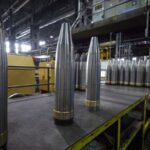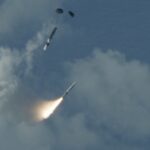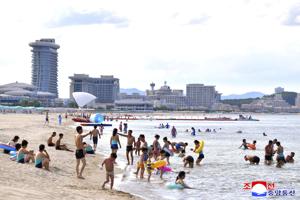SEOUL, South Korea (AP) — North Koreans are taking to the waters at a newly inaugurated beach resort, engaging in activities such as swimming and water park rides, according to state media reports on Wednesday. This development comes as the nation continues to enforce stringent bans on foreign visitors, highlighting a domestic focus on tourism.
The resort, located on the eastern coast of North Korea, is being promoted as a significant boost for the country’s tourism sector. Despite international sanctions and travel restrictions, the government is investing in infrastructure aimed at enhancing domestic tourism experiences for its citizens.
Domestic Tourism in Focus
The opening of the beach resort represents a strategic shift towards nurturing internal tourism amid ongoing global isolation. North Korea’s leader, Kim Jong-un, has been vocal about the importance of developing leisure facilities to improve the quality of life for North Koreans and to demonstrate the country’s self-reliance.
State media has showcased images of families enjoying the beach, with children playing in the sand and adults relaxing by the water. The resort is equipped with various amenities, including water slides and leisure pools, designed to cater to a broad range of visitors.
Economic Context and Historical Parallels
Historically, North Korea has struggled to attract international tourists due to its political climate and strict travel regulations. However, the country has periodically attempted to develop its tourism industry as a means of generating revenue. The newly opened resort is part of a broader plan to revitalize the economy through domestic tourism, especially as international options remain limited.
Experts note that this focus on internal tourism is reminiscent of past efforts during periods of heightened international tension. In the 1980s, for instance, North Korea invested in similar projects to bolster national pride and provide leisure opportunities for its citizens.
Expert Opinions and Future Implications
According to analysts, the development of such resorts could serve multiple purposes. Dr. Lee Sung-yoon, a professor of Korean studies, suggests that these projects are designed to instill a sense of normalcy and prosperity among the population. “By creating these leisure spaces, the regime aims to project an image of stability and progress,” he explains.
However, the long-term viability of these initiatives remains uncertain. The country’s economic challenges, exacerbated by international sanctions and the COVID-19 pandemic, pose significant hurdles. The sustainability of such tourism projects will largely depend on the government’s ability to maintain and expand these facilities without external support.
“By creating these leisure spaces, the regime aims to project an image of stability and progress.” — Dr. Lee Sung-yoon, Professor of Korean Studies
Looking Ahead
As North Korea continues to grapple with international isolation, the focus on domestic tourism is likely to persist. The newly opened beach resort is a testament to the regime’s commitment to providing recreational outlets for its citizens, albeit within a constrained environment.
Observers will be watching closely to see if this model of tourism development can be sustained and whether it will have any meaningful impact on the country’s economic landscape. For now, the beach resort stands as a symbol of North Korea’s attempt to navigate its unique challenges through self-reliance and internal development.
About The Author
 Pentagon Halts Key Munitions Shipments to Ukraine Amid Strategic Review
Pentagon Halts Key Munitions Shipments to Ukraine Amid Strategic Review Pentagon’s R&D Budget Proposal Signals Shift Toward Agile Warfare
Pentagon’s R&D Budget Proposal Signals Shift Toward Agile Warfare UPenn Revises Lia Thomas Swimming Records Amid Federal Settlement on Transgender Athlete Participation
UPenn Revises Lia Thomas Swimming Records Amid Federal Settlement on Transgender Athlete Participation Viral Video Misrepresents Myanmar Quake Damage as Bangladesh Corruption
Viral Video Misrepresents Myanmar Quake Damage as Bangladesh Corruption Australia Tightens Childcare Safety Laws Amid Abuse Scandal
Australia Tightens Childcare Safety Laws Amid Abuse Scandal